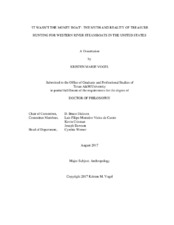| dc.description.abstract | This dissertation chronicles the historical record of the attempt to recover treasure from buried western river steamboats in the United States by examining the site formation of steamboat wreck sites, treasure myths, protective legislation regarding historic shipwrecks, and treasure hunting attempts from the late-nineteenth century to modern day. Primary accounts from the nineteenth century through current day, including newspapers, magazines, literature, narratives written by treasure hunters, legislative agendas, legal documents, and court case proceedings, were utilized. Seven case studies of steamboats targeted by treasure hunters were included: Missouri Packet (1820), Ben Sherrod (1837), Arabia (1856), Twilight (1865), Bertrand (1865), Leodora (1866), and City of New Orleans (unidentified). Each of these vessels sunk in the nineteenth century and later became the target of treasure seekers who hoped to recover valuables.
In the nineteenth century, the steamboat was a crucial mode of transportation of goods and people. Cargoes included foodstuffs, raw materials, ceramics, clothing, alcoholic spirits, and tools. Basically, if it was needed or wanted, it could be found in the cargo hold of a steamboat. Despite their utility, transporting goods by steamboat involved risk. Accidents—including boiler explosions or being impaled by snags—were common. In many cases, the boat sank after an accident. Some steamboats and their cargo were salvaged shortly after they sank. Others were abandoned, either inaccessible or forgotten.
An abandoned vessel potentially holds thousands of artifacts, some of it with potential market value. Thus, western river steamboats have become the subject of treasure hunting lore. These tales focused on rumored whiskey cargoes and precious metals buried on steamboats along the Ohio, Mississippi, and Missouri rivers and their tributaries. Treasure hunters of late nineteenth century attempted to get at the rumored treasure but often failed due to difficult conditions. Later attempts proved to be more thorough, and they could also prove to be more destructive to the archaeological record. Treasure hunters have recovered thousands of artifacts but no treasure troves. Some have worked to conserve and display artifacts. At the same time, treasure hunting methods are often at odds with archaeological principles and the conservation of cultural heritage. | en |


